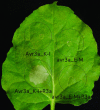An ancestral oomycete locus contains late blight avirulence gene Avr3a, encoding a protein that is recognized in the host cytoplasm
- PMID: 15894622
- PMCID: PMC1140420
- DOI: 10.1073/pnas.0500113102
An ancestral oomycete locus contains late blight avirulence gene Avr3a, encoding a protein that is recognized in the host cytoplasm
Abstract
The oomycete Phytophthora infestans causes late blight, the potato disease that precipitated the Irish famines in 1846 and 1847. It represents a reemerging threat to potato production and is one of >70 species that are arguably the most devastating pathogens of dicotyledonous plants. Nevertheless, little is known about the molecular bases of pathogenicity in these algae-like organisms or of avirulence molecules that are perceived by host defenses. Disease resistance alleles, products of which recognize corresponding avirulence molecules in the pathogen, have been introgressed into the cultivated potato from a wild species, Solanum demissum, and R1 and R3a have been identified. We used association genetics to identify Avr3a and show that it encodes a protein that is recognized in the host cytoplasm, where it triggers R3a-dependent cell death. Avr3a resides in a region of the P. infestans genome that is colinear with the locus containing avirulence gene ATR1(NdWsB) in Hyaloperonospora parasitica, an oomycete pathogen of Arabidopsis. Remarkably, distances between conserved genes in these avirulence loci were often similar, despite intervening genomic variation. We suggest that Avr3a has undergone gene duplication and that an allele evading recognition by R3a arose under positive selection.
Figures





References
Publication types
MeSH terms
Substances
Associated data
- Actions
- Actions
- Actions
LinkOut - more resources
Full Text Sources
Other Literature Sources
Molecular Biology Databases

